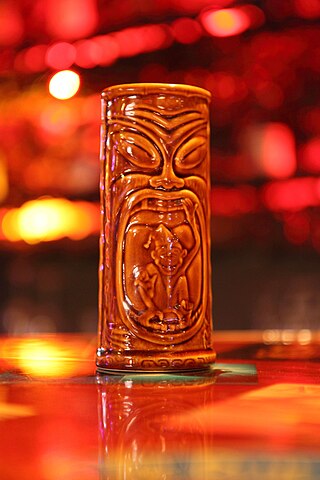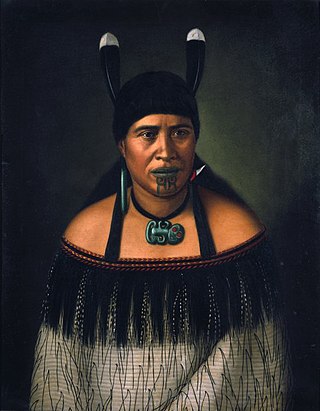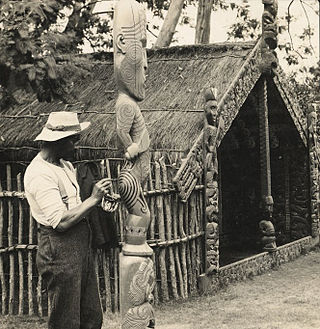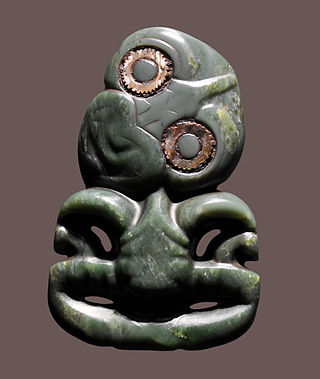Related Research Articles

Tiki culture is an American-originated art, music, and entertainment movement inspired by Polynesian, Melanesian, and Micronesian cultures, and by Oceanian art. Influential cultures to Tiki culture include Australasia, Melanesia, Micronesia, Polynesia, the Caribbean Islands, and Hawaii. The name comes from Tiki, the Māori name for the first human, often represented in the form of hei-tiki, a pendant and important taonga. The hei-tiki was often appropriated by Europeans as a commercialised good luck charm, hence the name of Tiki culture. Despite spanning over 10,000 miles and including many different unrelated cultures, religions, and languages, Tiki aesthetic is considered by some to be amalgamated into one "fantasia of trans-Pacific cultures" and "colonial nostalgia". Because of this, and the simplistic view of the Pacific taken by the aesthetic, Tiki culture has often proved controversial.

The hei-tiki is an ornamental pendant of the Māori of New Zealand. Hei-tiki are usually made of pounamu (greenstone), and are considered a taonga (treasure) by Māori. They are commonly called tiki by New Zealanders, a term that originally refers to the first mortal.
Takatāpui is a Māori language term that is used in a similar way to LGBT. When speaking Māori, LGBT people of any culture are referred to as takatāpui. In English, a takatāpui person is a Māori individual who is gay, lesbian, bisexual, or transgender (LGBT).

A hei matau is a bone or greenstone carving in the shape of a highly stylised fish hook. They represent good luck and safe travel across water.

In Māori mythology, Tiki is the first man created by either Tūmatauenga or Tāne. He found the first woman, Marikoriko, in a pond; she seduced him and he became the father of Hine-kau-ataata. By extension, a tiki is a large or small wooden, pounamu or other stone carving in humanoid form, notably worn on the neck as a hei-tiki, although this is a somewhat archaic usage in the Māori language. Hei-tiki are often considered taonga, especially if they are older and have been passed down throughout multiple generations. Carvings similar to ngā tiki and coming to represent deified ancestors are found in most Polynesian cultures. They often serve to mark the boundaries of sacred or significant sites. The word has cognates in other Polynesian languages, such as tiʻi in Tahitian and kiʻi in Hawaiian. In the Western world, Tiki culture, a movement inspired by various Pacific cultures, has become popular in the 20th and 21st centuries.
William Tucker was a British convict, a sealer, a trader in human heads, an Otago settler, and New Zealand’s first art dealer.

Jewellery making in the Pacific started later than in other areas, due to relatively recent human settlement. Early Polynesian jewellery, which was made of bone, wood and other natural materials, has not survived. The precise start of island jewellery-making is difficult to pinpoint, due to many of the island nations' founders migrating there from other areas, such as Tahiti.

Te Whānau-ā-Apanui is a Māori iwi (tribe) located in the eastern Bay of Plenty and East Coast regions of New Zealand's North Island. In 2006, the iwi registered 11,808 members, representing 13 hapū.

Waka huia and Papa hou are treasure containers made by Māori – the indigenous people of New Zealand. Waka huia was also the name of a long-running TV series on TVNZ.

Taonga pūoro are the traditional musical instruments of the Māori people of New Zealand.
Edwin "Ted" Coubray was a New Zealand projectionist, filmmaker and inventor. He was born in Eastern Bush, Southland, New Zealand, and died in Homebush, Sydney. He retired to Australia in 1973 after Auckland Cinemas, for which he was working, closed the Tudor Cinema in Remuera.
Under the Southern Cross also known as The Devil's Pit or Taranga, is a 1929 American drama film set in New Zealand, directed and produced by Lew Collins for Universal Studios, who also wrote the screenplay. Originally titled Taranga by the original director Alexander Markey, the film was completed by Collins and released as Under the Southern Cross in 1929. After the introduction of sound, the film was given a soundtrack and retitled as The Devil’s Pit in 1930. The film was shot on White Island, which has an active volcano.
Alexander Markey (1891–1958) was an American filmmaker and founder of Markey Films. He was born in Hungary and died in Switzerland.

The Wagon and the Star is a 1936 New Zealand film by producer and director J.J.W. Pollard, who also wrote the screenplay. Only one reel of the film and some out-takes survived and is considered lost film by Ngā Taonga Sound & Vision. The handbuilt camera used was built by Ted Coubray and "confiscated" by Alexander Markey on the set of Hei Tiki.
Peter Adds is Wellington-based academic, treaty negotiator and former head of Victoria University of Wellington's Te Kawa a Māui/School of Māori Studies. He is of Te Ati Awa descent. With a background in anthropology and archaeology, he has interests in Treaty of Waitangi settlements, indigenous astronomy, Māori development, and international indigenous issues.
Rangi Kipa is a New Zealand sculptor, carver, illustrator and tā moko artist.
Māori Indians are an ethnic group in New Zealand of people with mixed Māori and Indian ancestry.

Pounamu is a term for several types of hard and durable stone found in the South Island of New Zealand. They are highly valued in New Zealand, and carvings made from pounamu play an important role in Māori culture.
Whareakeake is a beach 25 kilometres (16 mi) northeast of Dunedin in the South Island of New Zealand, as well as the valley above and behind the beach. Located to the west of Aramoana and included as a section of the Otago Heads, Whareakeake was a place of habitation for Māori people from early times until the Sealers' War skirmish of 1817 from which it derived its colonial name. It is now a surfing beach renowned for its right-hand point break.
Kōhine Tewhakarua Pōnika was a New Zealand composer known for her Māori waiata (songs).
References
- New Zealand Film 1912-1996 by Helen Martin & Sam Edwards p. 46 (1997, Oxford University Press, Auckland) ISBN 019 558336 1